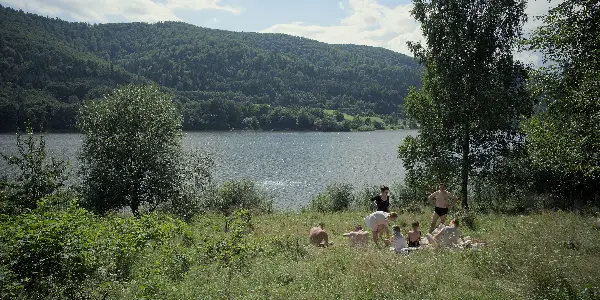Movies surrounding the Holocaust and World War II are far from new. The continuous introduction of more films over the years, and still more to come, speaks to the breadth of perspectives on a global scale. This was not something that affected one person, one country, one continent, but rather a war that engulfed the entire world. Yet, as much as we have become continuing witnesses to the victims that befell the consequences of war and genocide, often times these films have stayed on one side of the war. Jonathan Glazer‘s The Zone of Interest is a hauntingly deep and tragic film focused on the periphery behind enemy lines. From its publicity stills, it feels far removed from the war its synopsis claims, even farther removed from the sheer brutality and death that resides are just over the wall.
A Hauntingly Disturbing Depiction
Premiering at the Cannes Film Festival earlier this year, The Zone of Interest was an instant success, hailed by many as both a haunting and riveting examination of the brutality of mankind. Not by just the physical actions, but the ability to compartmentalize and live the life of an elite whilst genocide is occurring on the other side of the compound’s gates. And every description has held true. The Zone of Interest is a haunting film that will reverberate within the depths of your soul. The most immediate horror is not just in the sounds of violence and death constantly heard throughout the film, but the lack of response by the characters on screen. The sounds of gunfire and screams of Jews at Auschwitz fall on deaf ears, lending to a strong comparison of white noise. The sounds fade to the distance, ever present but an element on the peripheral our characters have compartmentalized as not only a part of the war, but a necessary correction for themselves and Germany..

Sound is a strong component in The Zone of Interest, not only in the crafting of its haunting white noise, but also in its score from composer Mica Levi. Early on, the film works to juxtapose the reality behind the gate and the life constructed at the manor. As the film opens, audiences are met with a black screen, with only the Levi‘s opening score to great them. The opening score feels meditative, similar to the sounds one would expect at a spa or a massage parlor. Yet it is unnerving as a treacherous undertone accompanies the tranquility, reverberating deep in you heart. The opening score pulsates with danger and immorality.
The closing score appropriately bookends The Zone of Interest, yet more intensely piercing and heart-pumping, feeling like the after math of disaster that lingers beneath the skin. It drives hard the finality of the film and its depiction of an upperclass German family’s – albeit a country’s – indifference to the suffering that lives beside them. A suffering they have imposed in the name of purification.
There is a deep connection formed between sound and sight within The Zone of Interest one the harsh light of day breaks the film’s opening black screen. The “white noise” of the camps is met with the tranquility of the garden on the manor. Much to the same fashion as the opening score, a peaceful imagery of flowers is juxtaposed against the sounds of the horrors that are happening just beyond the gate. Visuals work too on the periphery. Audiences will remain on the manor with the Höss family through the film’s entirety. Much like the family, we remain guarded behind the walls, with limited visual perspective of the horrors behind the gate.
One of the most impactful moments, of many, devises an almost first-person perspective, the audience standing behind Rudolf Höss (Christian Friedel), crafting a shared viewpoint. Yet, as he watches the children play in the pool before him, we as an audience take in the horrors of a train approaching the camp – horrifyingly, we know what the train is carrying. scenes similar to these come up frequently throughout The Zone of Interest, the visual aspects of living next to Auschwitz becoming as much of a “white noise” as the sounds constantly emanating from over the wall. These moments work both alone and in unison to further establish the periphery sense of existence behind the gate in a deeply haunting fashion.
Conclusion
While The Zone of Interest works with the idea of horror on the periphery, its characters are far from immune. They lay awake at night, parents up late talking over the noise, children roaming the home whilst starring at the smoke stacks glaring in the night. The moral ambiguity of their concise belief in the daytime begins to fall away within the darkness. Everyone has a conscience, for many, night fall being the only time it can truly manifest to the surface.
Jonathon Glazer‘s The Zone of Interest is a hauntingly reverberating film that will stick with its audience long after the film has concluded. While experimental in its nature at times, it is a masterclass of historical horror and skill in both its audio and visual constructions.
Does content like this matter to you?
Become a Member and support film journalism. Unlock access to all of Film Inquiry`s great articles. Join a community of like-minded readers who are passionate about cinema - get access to our private members Network, give back to independent filmmakers, and more.